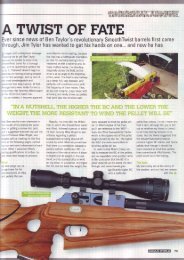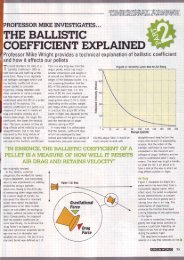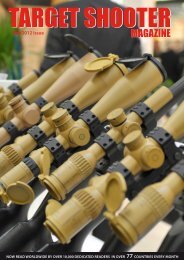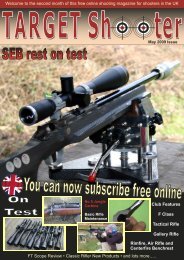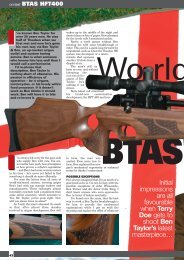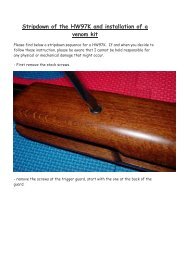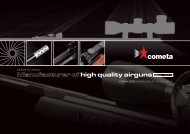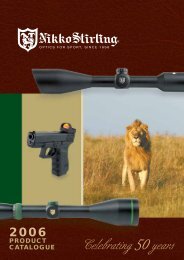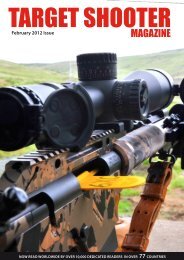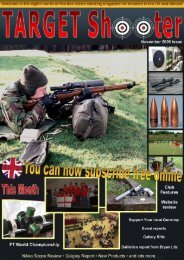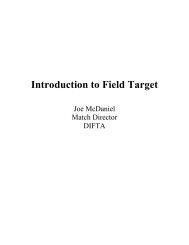MAGAZINE
MAGAZINE
MAGAZINE
- No tags were found...
You also want an ePaper? Increase the reach of your titles
YUMPU automatically turns print PDFs into web optimized ePapers that Google loves.
THE HANDLOADING BENCH308 Winchester Rides Again Part 3By Laurie Hollandrange of speeds and conditions.ConsWell, we’ve seen the ‘pros’ and they’re all related topredicted long-range external ballistics performance.Everybody will have switched to the more efficient‘heavies’ surely? ..... but, no. if you revisit the reporton the F Class European Championship meeting inthe December issue of TS Online, you’ll see a tablelisting what kit and loads were used by the top 10 F/TR shooters. Runaway winner Stuart Anselm used anintermediate weight model, the 185gn Berger BTLR;four used 210gn ‘heavies’, another four loaded Berger155.5s, and the final odd-man out (sole non Bergeruser) shot the Australian 155gn BJD-HBC. However,the winds weren’t very strong over that weekend –if an early winter weather depression with 20 mphplus winds had blown in, ‘heavies’ users might haveoutnumbered the 155gn brigade in the top spots.Let’s look at the ‘cons’, and the overwhelmingdownsides are an increase in recoil and torque.Increasing the bullet weight from 155 to 210gnincreases recoil energy by over 20% in an 18lb F/TRrifle, from 8.7 to 10.6 ft/lbs. That might not soundmuch, but it will affect rifle handling and bi-podmovement on the ground. I notice that some of themore successful heavy bullet shooters have fittedspikes to the bi-pod feet allowing them to ‘load thebi-pod’, that is lock the foot position and put the legsunder tension to reduce movement and eliminate thedreaded bi-pod leap in the air that not only affectsshot to shot consistency, but can see you unknowinglylined up on the neighbouring target for the next shotwith the consequent risk of cross-shooting and aguaranteed loss of five points. A heavier bullet alsoputs more stress on every major component in therifle from the barrel through the receiver and boltto the bedding. In my look at the ‘pros’, there wasthe proviso that ‘heavies’ will produce the same sizegroups as 155s, but there is a lot of evidence thatwhile it’s possible to achieve this, it’s very hard to doso. For whatever reason or reasons, most heavy bulletshooters say their long-range ‘elevations’ are biggerthan they expect from a good 155gn bullet load, andthis is the ‘swing’ you lose on against the gains fromthe reduced wind drift ‘roundabout’. High energydouble-base powders are de rigueur in the 308’sconstrained capacity case to get full velocities fromthese bullets, and this allied to greater bullet inertiawill see throat erosion and damage set in quicker,so barrel life will be reduced, likely to 2,000-2,500rounds.Next month: twist rates, chamber throat lengths,powders, loads and 200-210gn bullet results tofinish things off.Table 1External Ballistic Performance from Heavy 0.308” Match BulletsBullet i7 BC V0 (fps) Twist V1,000 (fps) D1,000 (MOA / Inches)155.5 BT FB 0.988 0.237 3,000 12.5” 1,304 (1.16 M) 8.7 / 91”190gn Sierra MK 1.070 0.268 2,714 12.1” 1,269 (1.13 M) 8.6 / 90”190gn Berger VLD 0.982 0.291 2,714 11.7” 1,364 (1.21 M) 7.6 / 80”200gn Sierra MK 1.058 0.285 2,645 11.9” 1,292 (1.15 M) 8.2 / 86”200gn Berger Hybrid 0.944 0.320 2,645 10.6” 1,417 (1.26 M) 7.0 / 73”208gn Hornady A-Max 0.966 0.324 2,594 10.5” 1,393 (1.24 M) 7.1 / 74”210gn Berger VLD 0.985 0.321 2,582 11” 1,375 (1.22 M) 7.2 / 76”210gn Berger BTLR 0.988 0.320 2,582 11.25” 1,371 (1.22 M) 7.3 / 76”210gn Sierra MK 1.000 0.316 2,582 11.1” 1,359 (1.21 M) 7.4 / 77”215gn Berger Hybrid 0.910 0.356 2,551 10.3” 1,454 (1.29 M) 6.4 / 67”220gn Sierra MK 1.068 0.310 2,522 11.2” 1,296 (1.15 M) 7.9 / 83”230gn Berger Hybrid 0.911 0.380 2,467 10” 1,450 (1.19 M) 6.2 / 65”72



